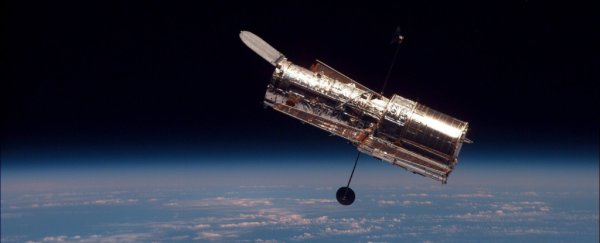After a gyroscope failure put the Hubble Space Telescope out of action on October 5, NASA engineers finally see an end to its troubles. They have its backup gyroscope operating within a normal range and expect science operations to resume imminently.
The space telescope entered a low-power safe mode in early October, suspending science operations while engineers here on Earth diagnosed, then attempted to fix the problem.
At maximum efficiency, Hubble uses three gyroscopes for orienting itself to observe a target in the sky. These gyros measure the speed at which the telescope turns, so that it can be aimed accurately.
Each of Hubble's gyroscopes contain a wheel suspended in thick, oil-like fluid sealed in a cylinder. This wheel spins at a rate of 19,200 revolutions per minute, with power supplied by fine, hair-like wires.
As you can imagine, such a delicate instrument has a relatively high failure rate, particularly in the degradation of the wires. Which is why, on a repair mission in 2009, Hubble was equipped with six new gyros - including three technically enhanced backups in the event of failure.
The early October gyro that failed was the last of the three regular ones to go, so Hubble engineers switched on the last of the enhanced gyros after 7.5 years in hibernation. Theoretically, they should have a much longer operational life than the unenhanced gyros.
But there was a big problem - the gyro was reporting rotation rates that were far too high.
"This is similar to a speedometer on your car continuously showing that your speed is 100 miles per hour (160 km/h) faster than it actually is; it properly shows when your car speeds up or slows down, and by how much, but the actual speed is inaccurate," public affairs officer Felicia Chou wrote in an update on the NASA website.
The gyros operate in two modes, high and low. High mode is for larger movements, such as swinging the telescope's aim across the sky from one target to another. Low mode is for the finer rotations as Hubble makes the small adjustments needed to lock onto a target and holds it.
The first attempt to fix the incorrect speed reporting took place on October 16, when NASA engineers executed a running restart of the gyro. This was unsuccessful.
So they went in hard on October 18, essentially jiggling the telescope with carefully executed turns.
"The Hubble operations team commanded a series of spacecraft manoeuvres, or turns, in opposite directions to attempt to clear any blockage that may have caused the float to be off-center and produce the exceedingly high rates," Chou wrote.
"During each maneouvre, the gyro was switched from high mode to low mode to dislodge any blockage that may have accumulated around the float."
After these manoeuvres, the rotation rates reported to Earth dropped to a normal level, and remained so over a series of test moves.
Hubble really is an impressive piece of technology. It was launched into orbit in 1990, and, after several mission extensions, has been up there for nearly 30 years.
The most recent (and final) service mission took place in 2009, and was expected to extend its life until "at least 2013".
All of the telescope's science instrumentation is still fully operational, and in a pinch it can operate using just one of its gyros, so it's expected the telescope will provide at least a few more years of science.
Eventually, however, its time will come to an end. If technical failure doesn't bring it down, gravity will. Hubble is on a very slight orbital decay, and eventually engineers will need to implement a controlled descent so that it doesn't come crashing down on our heads.
In the meantime, though, science operations are set to resume soon. NASA engineers just need to run it through the paces expected for normal observations, such as moving to a target, locking on, and precision pointing, to make sure it's up to scratch.
